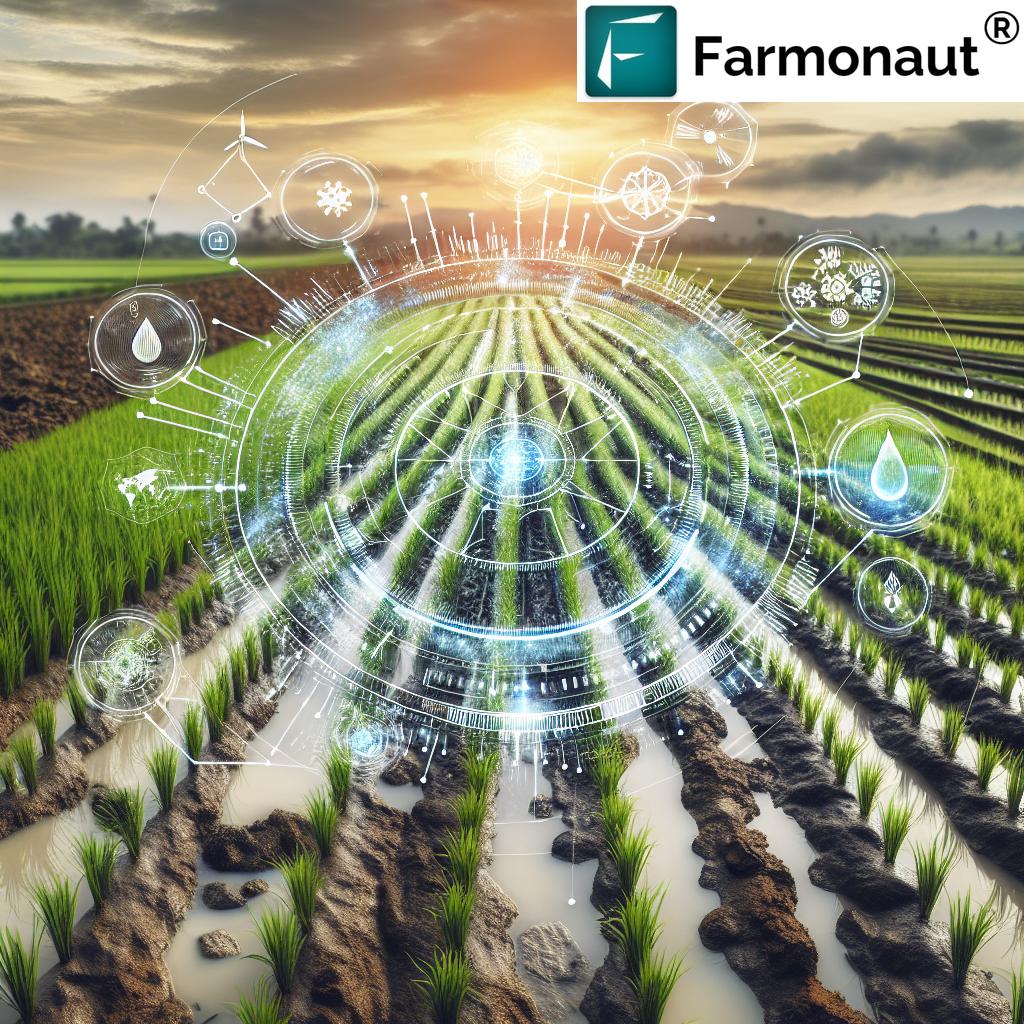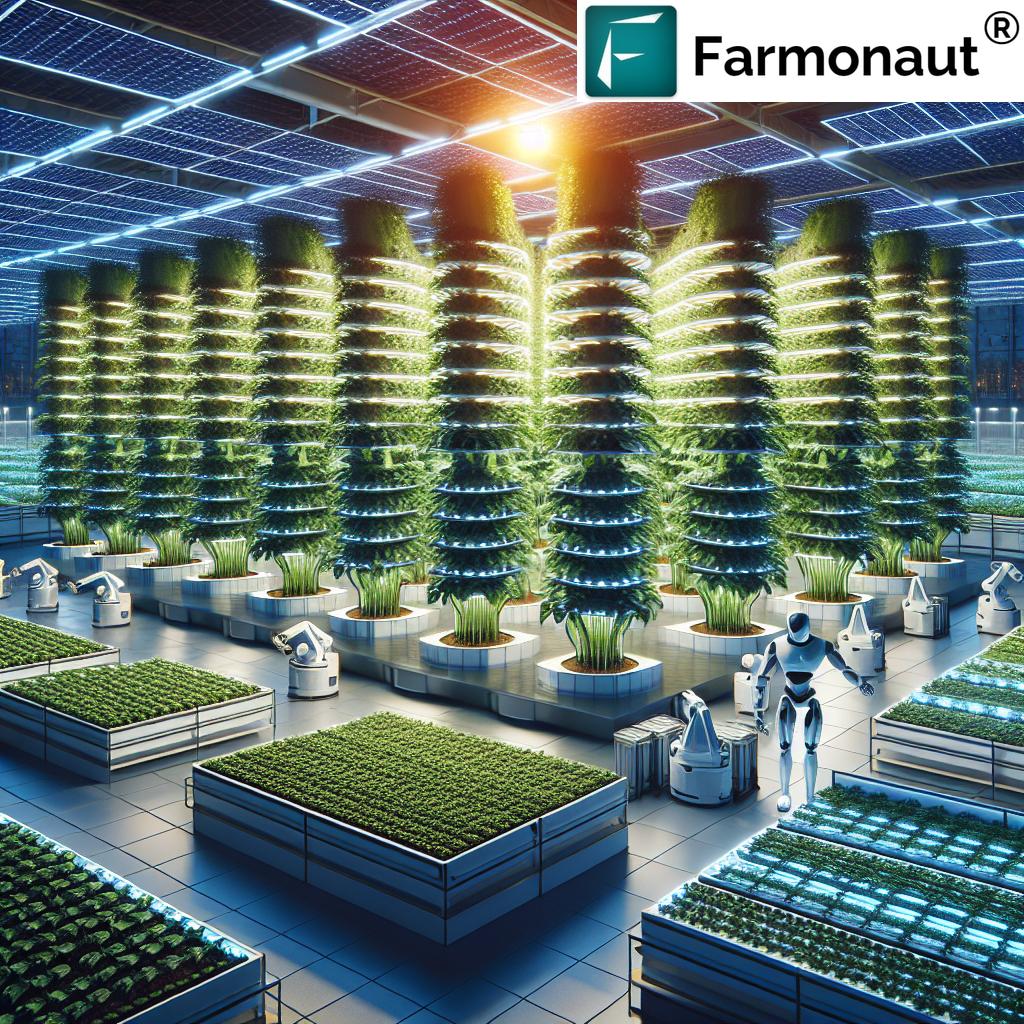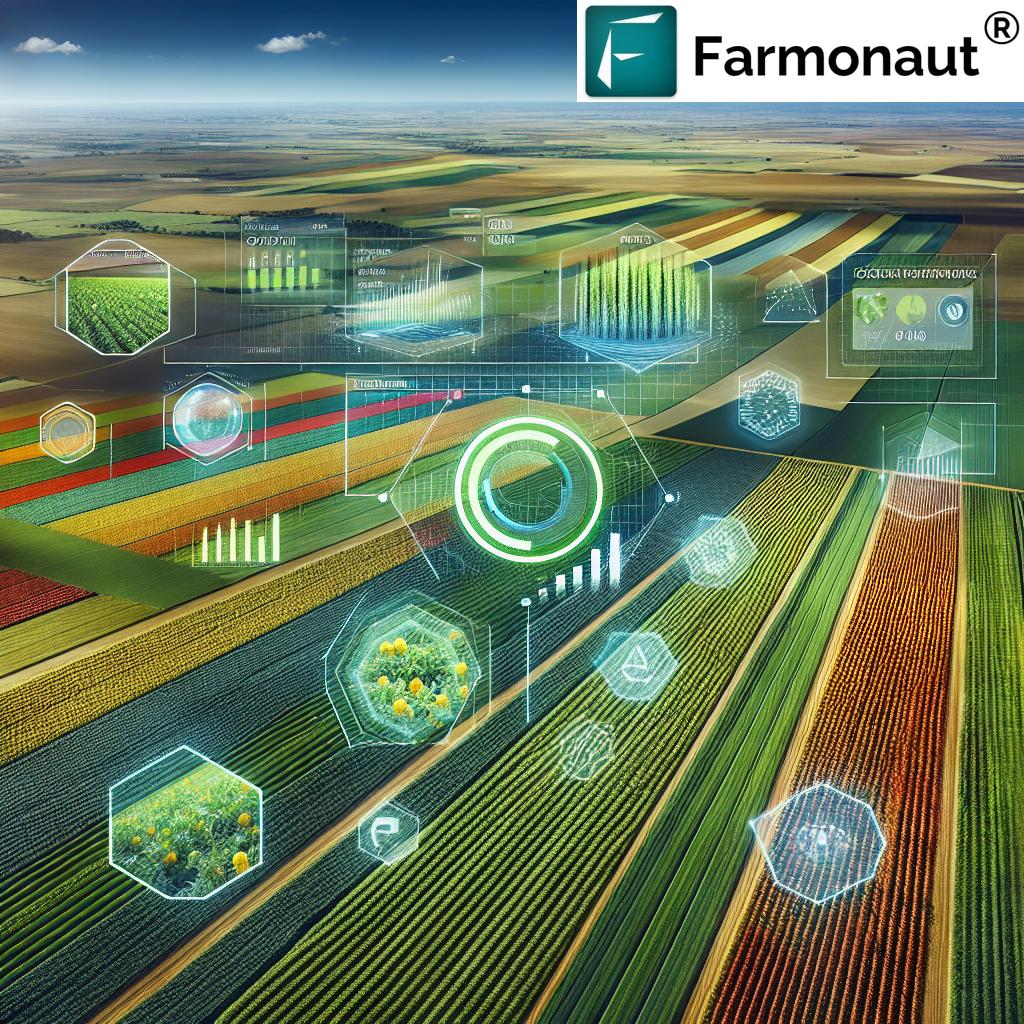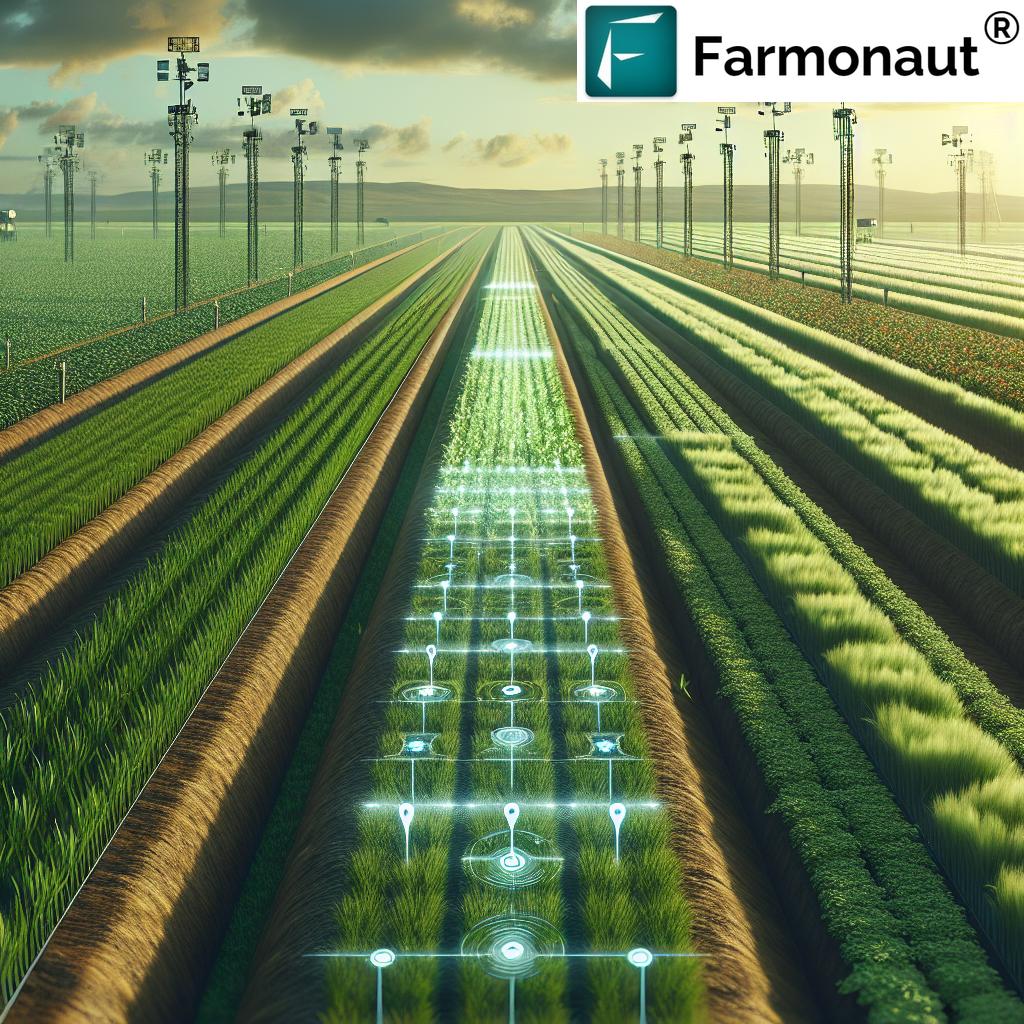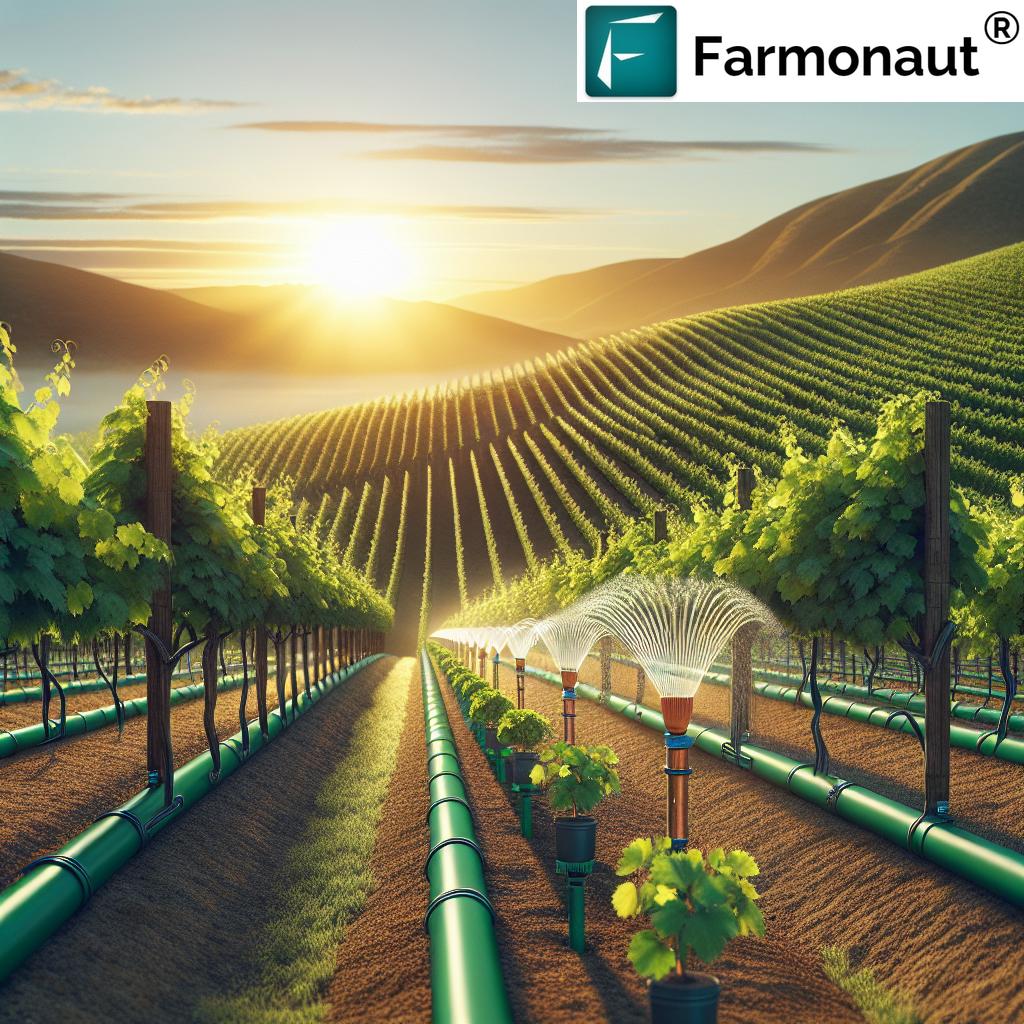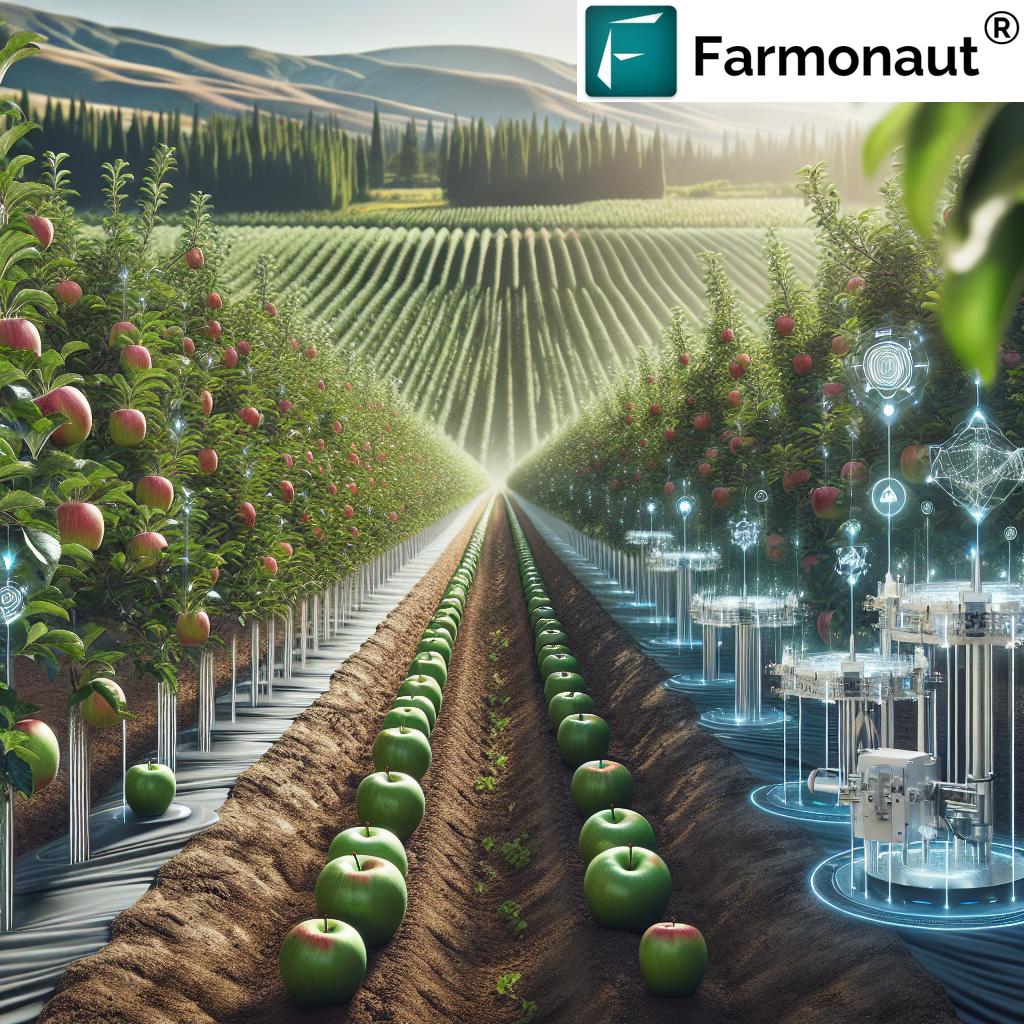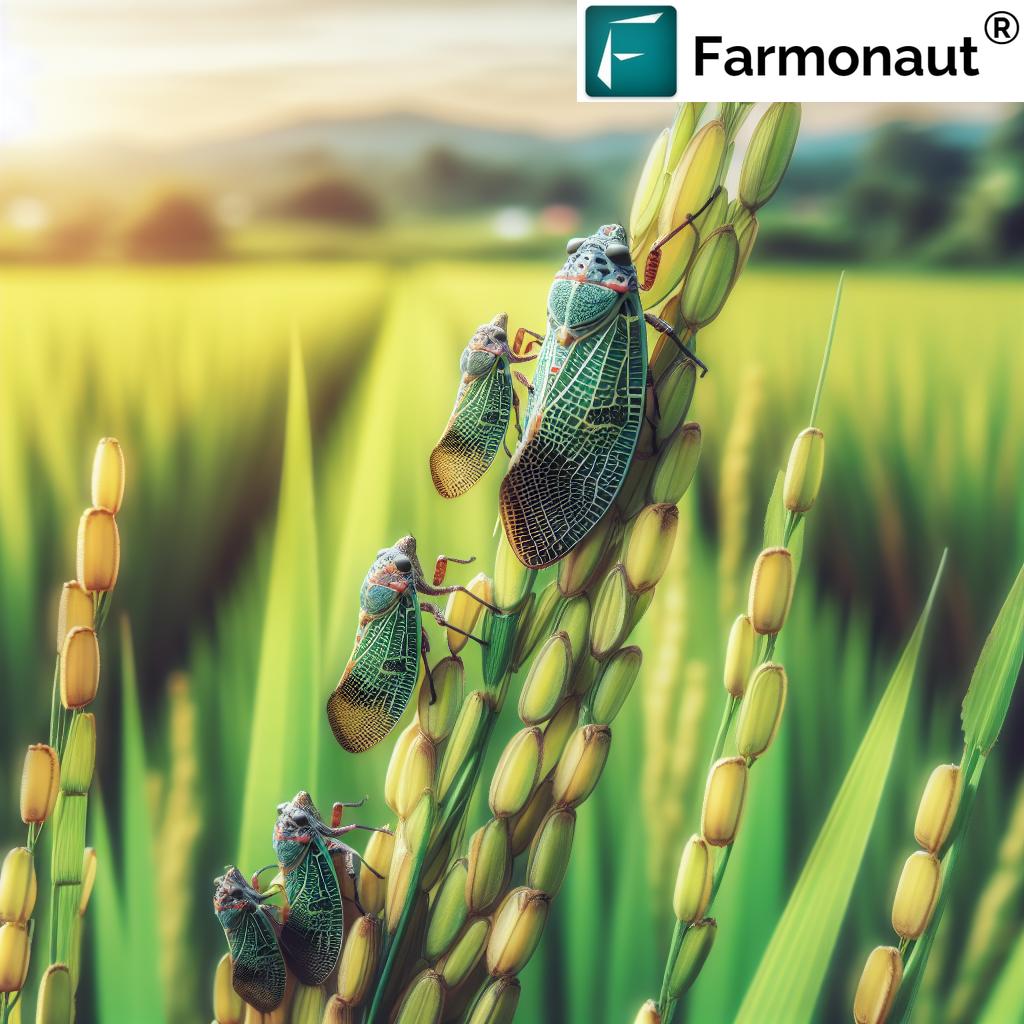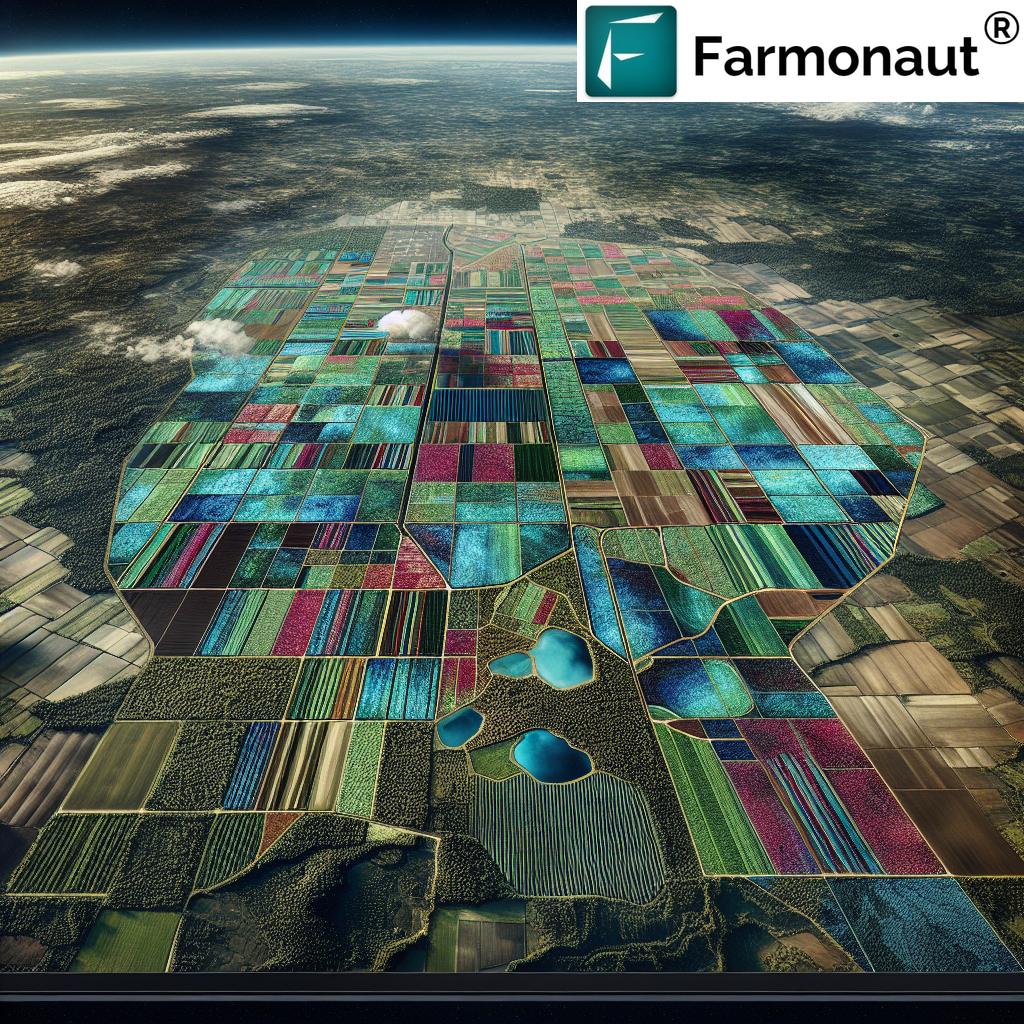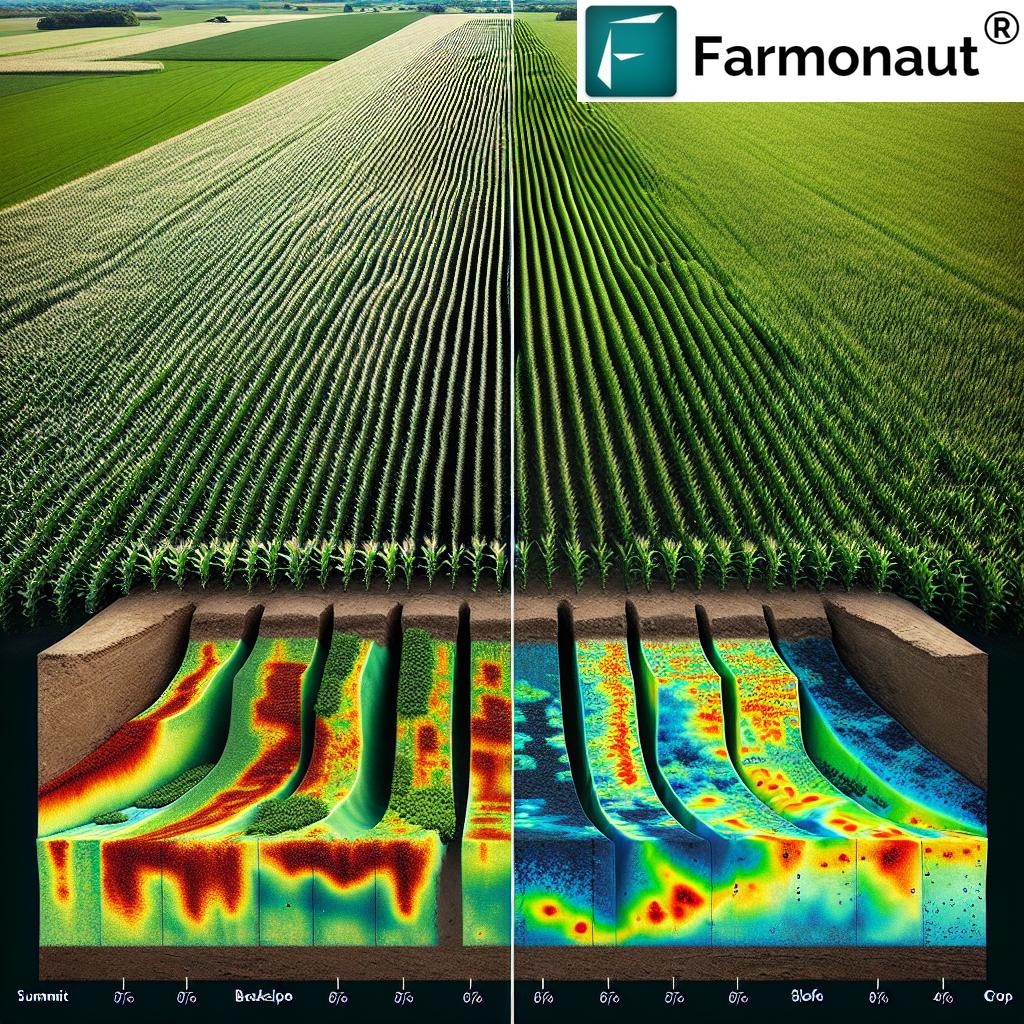How Technology Improves Crop Yields: 7 Powerful Innovations
Discover how precision agriculture, smart irrigation systems, and advanced agri-tech innovations are increasing crop yields, optimizing water use, and enhancing farming efficiency.
“Precision agriculture can increase crop yields by up to 20% through targeted fertilizer and pesticide application.”
Table of Contents
- Introduction: Technology’s Role in Modern Agriculture
- Comparative Summary Table: 7 Innovations
- 1. Precision Agriculture: Data-Driven Field Management
- 2. Smart Irrigation Systems: Efficient Water Use
- 3. Robotics and Automation in Farming
- 4. Controlled-Environment Agriculture, Aeroponics & Vertical Farming
- 5. Agrivoltaics: Solar Panels & Crops, Together
- 6. Artificial Intelligence & Machine Learning in Agriculture
- 7. Alternate Wetting and Drying & Deficit Irrigation Strategies
- Farmonaut Technologies: Making Precision Farming Accessible
- Frequently Asked Questions
- Conclusion: Shaping the Future of Sustainable Agriculture
Introduction: Technology’s Role in Modern Agriculture
The global demand for food continues to grow, all while agriculture faces mounting challenges—climate change, water scarcity, labor shortages, and resource limitations. Yet, the industry’s resilience and adaptability shine through as technology transforms farming. From precision agriculture to artificial intelligence in agriculture and smart irrigation systems, these innovations are not just raising crop yields and productivity but doing so sustainably.
This comprehensive guide reveals how technology improves crop yields through seven powerful advancements. By integrating innovative tools and methodologies, farmers can optimize resource use, improve efficiency, and address the complexities of modern food production.
Comparative Summary Table: 7 Technology Innovations for Crop Yield Improvement
For easy reference, the table below compares seven major agricultural technology innovations. Not only do these technologies increase crop yields, but they also enable farmers to optimize water use efficiency, address environmental challenges, and boost overall productivity.
| Innovation Name | Core Technology | Estimated Crop Yield Improvement (%) | Water Use Efficiency (Estimated Savings %) | Impact on Farming |
|---|---|---|---|---|
| Precision Agriculture | GPS, Remote Sensing, IoT | 10–20% | 15–20% | Targeted input application, real-time monitoring, waste & cost reduction, enhanced growth conditions & yield |
| Smart Irrigation Systems | IoT Sensors, AI, Weather Data | 5–15% | 30–50% | Precise, timely irrigation, reduced water usage, optimal crop growth, climate-smart farming |
| Robotics & Automation | Robotics, AI, Machine Learning | 10–30% | 5–10% | Automated planting, weeding, and harvesting; reduced labor dependence; higher consistency and productivity |
| Controlled Environment Agriculture | LED Lighting, Climate Control, Hydroponics/Aeroponics | 20–50% | Up to 70% | Year-round, high-density production; space/water-efficient techniques; less dependency on arable land |
| Agrivoltaics | Solar Panels, IoT | 5–20% | 5–15% | Combined solar energy and crop cultivation; partial shade for drought/heat-sensitive crops |
| Artificial Intelligence & Machine Learning | AI Algorithms, Satellite Imagery, Data Analytics | 10–25% | 10–12% | Predictive analytics for disease, weather, and yield; optimal timing for planting & harvesting |
| Alternate Wetting & Drying / Deficit Irrigation | Irrigation Scheduling, IoT Sensors | 5–20% | 25–40% | Efficient rice and wheat cultivation; saves water; maintains or even boosts grain yield |
“Smart irrigation systems can reduce water usage in farming by as much as 30% while maintaining optimal crop growth.”
1. Precision Agriculture: Data-Driven Field Management
Precision agriculture has dramatically transformed traditional farming by bringing technology to the heart of every field. This innovative approach employs GPS, remote sensing, and IoT systems to monitor and manage variability across different sections of a field. By leveraging advanced tools and data-driven insights, farmers can assess real-time soil conditions, crop health, and resource requirements with remarkable accuracy.
- Variable-Rate Application: GPS-guided systems enable the precise application of fertilizers and pesticides, ensuring each area receives exactly what it needs.
- Field Mapping: Accurate mapping with remote sensors helps identify nutrient deficiencies, pest infestations, and other critical field-level issues.
- Resource Optimization: By avoiding the overuse of chemicals and water, waste is reduced and both costs and environmental impact are minimized.
- Higher Yields: Farmers can increase crop yields by up to 20% and improve water use efficiency in agriculture, thanks to optimized input distribution (Source).
- Climate-Smart Farming Techniques: By collecting and analyzing data, precision agriculture addresses challenges posed by climate change and helps manage labor shortages.
From planting to harvesting, precision agriculture empowers farmers to make smarter, real-time decisions—maximizing productivity and sustaining both yields and the land.
2. Smart Irrigation Systems: Efficient Water Use
Smart irrigation systems are changing how water is managed on farms. With increasing water scarcity worldwide, especially in climate-vulnerable regions, these technologies help farmers optimize every drop.
- IoT-Enabled Sensors: Soil moisture sensors monitor real-time conditions, while weather forecasts enable adaptive planning.
- Automated Watering Schedules: Smart systems schedule irrigation based on the true needs of the crop, reducing water usage by up to 50% without sacrificing yield (Source).
- Remote Management: Many systems can be managed via apps or web interfaces, offering convenience and maximum efficiency.
- Weather-Integrated: Linking to local forecasts, these systems avoid overwatering and help buffer the effects of drought or excessive rainfall.
By leveraging smart irrigation, farms can enhance productivity, reduce input costs, and play a vital role in climate-smart farming techniques.
Did you know? Farmonaut’s satellite-based verification tools help financial institutions improve crop loan and insurance processes by providing accurate field and crop data. Read more:
Crop Loan and Insurance Solutions.
3. Robotics and Automation in Farming
The integration of robotics in farming is rapidly redefining the agricultural landscape. Driven by a need to address labor shortages and boost efficiency, autonomous robots and automated machinery are taking charge of tasks once reliant on manual labor.
- Automated Tractors & Harvesters: These self-driving machines utilize AI, GPS, and sensors for accurate planting, weeding, and harvesting (Source).
- Sensor Networks: Drones and ground robots monitor soil health, plant growth, and disease, enabling targeted interventions.
- Reduced Human Error: Consistency improves, resulting in higher quality crops and less wastage.
- Increased Productivity: Robots operate longer hours and can perform repetitive tasks efficiently, boosting production metrics for farms of all sizes.
Robotics and automation enable scalable, data-driven management—reinforcing sustainability while keeping yields and resource use optimized.
Explore Fleet Efficiency: With Farmonaut’s fleet management tools, large agribusinesses can monitor agricultural machinery, optimize vehicle usage, and reduce operational costs.
Discover Fleet Management Solutions
4. Controlled-Environment Agriculture, Aeroponics & Vertical Farming Technology
Controlled-environment agriculture (CEA) refers to methods where crops grow within rigorously regulated indoor spaces. Aeroponics and vertical farming technology are two standout approaches in this domain, proven to increase crop yields while optimizing resource use—even in urban or land-scarce environments.
- In aeroponics, plant roots are suspended in air and misted with nutrient-rich solutions. This method results in faster growth rates and water savings (Source).
- Vertical farming technology stacks plants in multiple layers, often integrating LED lighting and climate controls for year-round production.
- CEA systems can save up to 70% of water compared to conventional cultivation, as there is little evaporation and recycling is common.
- Controlled environments also reduce pest and disease pressure, decreasing reliance on fertilizers and pesticides.
- Crops can be grown close to markets, reducing logistics cost and the carbon footprint of food distribution.
By breaking free from traditional constraints, these innovative farming technologies enable production in areas previously unsuitable for agriculture and help address challenges posed by climate change and labor shortages.
Reduce your environmental impact: Farmonaut’s carbon footprinting tool allows agribusinesses to monitor emissions in real-time, enabling compliance and sustainability.
Learn More About Carbon Footprinting
5. Agrivoltaics: Solar Panels and Crops, Together
Agrivoltaics—the integration of solar panels with crop cultivation—is gaining traction as a smart solution that addresses both the need for renewable energy and efficient land use.
- Dual Land Use: Crops are cultivated beneath raised solar panels, powering farms while also growing food (Source).
- Improved Microclimate: The partial shade from the panels reduces moisture loss, lowers heat stress, and may moderate temperature swings—benefitting certain heat- and drought-sensitive crops.
- Yield Benefits: Research indicates some crops actually achieve higher yields and improved quality under these systems.
- Sustainability: This approach boosts water use efficiency in agriculture, as shaded soil preserves moisture and supports resilience in changing climates.
Agrivoltaics is a prime example of climate-smart farming that increases total productivity per acre and minimizes environmental impact.
Manage multiple plots easily: With Farmonaut’s large-scale farm management platform, users can oversee diverse land assets, monitor resource distribution, and maximize overall farm output.
See Large-Scale Farm Management Tools
6. Artificial Intelligence & Machine Learning in Agriculture
The use of artificial intelligence in agriculture and machine learning is opening a new frontier for data-driven decision-making. These technologies empower farmers to analyze vast datasets—ranging from weather patterns and soil moisture to multispectral imagery and yield history (Source).
- Predictive Analytics: AI-powered models can forecast disease outbreaks, optimal planting windows, and harvesting times based on real-time conditions.
- Yield Optimization: Machine learning algorithms identify the most productive hybrid or input combination for a given field—tailoring inputs for higher yield.
- Resource Management: AI systems optimize water, fertilizers, and pesticides for sustainable, cost-efficient production.
- Climate Adaptation: AI helps address climate change challenges by identifying patterns that may affect crop growth and recommending strategies for adaptation and resilience.
With AI and ML at their disposal, modern farmers can continuously improve productivity, reduce input costs, and minimize risk.
Leverage Real-Time Insights: Our Jeevn AI Advisory System delivers personalized, data-driven guidance, helping users boost crop health and resource use.
Explore AI and Traceability Solutions
7. Alternate Wetting and Drying & Deficit Irrigation Strategies for Water Use Efficiency in Agriculture
Alternate Wetting and Drying (AWD Method)
The alternate wetting and drying method (AWD) is revolutionizing rice cultivation, particularly in regions like India, Southeast Asia, and parts of Africa:
- Method: AWD alternately applies water, allowing rice fields to dry for set periods before the next irrigation.
- Benefits: Results in water savings of up to 38% with no adverse effect on yields—and sometimes even an increase, due to improved grain filling and root growth. (Source)
- Resource Efficiency: The technique boosts water productivity, ensuring every drop is used to its fullest potential.
- Sustainability: Less water usage reduces the burden on groundwater and supports ongoing agriculture despite climate pressures.
Deficit Irrigation Strategies
Deficit irrigation involves applying water below full crop requirements—ensuring enough is provided at critical phases without wastage:
- Planned Deficit Irrigation: In winter wheat cultivation in Turkey, deficit irrigation led to 65% yield gains compared to rainfed fields, and doubled water use efficiency (Source).
- Confirmed by Experiments: Many crops respond positively to careful deficit irrigation, with minimal yield reductions yet clear gains in water efficiency.
- Climate-Responsive: Particularly valuable in drought-prone areas, as it addresses the challenge of limited water availability.
Both the AWD and deficit irrigation strategies serve as practical, scalable techniques for wheat, rice, and other crops—boosting yield, improving resilience, and supporting the sustainability of global agriculture.
Farmonaut Technologies: Making Precision Agriculture Accessible & Affordable
At Farmonaut, we believe that the benefits of precision agriculture and data-driven farming techniques should be available to everyone—from smallholder farmers to vast agribusinesses. Here’s how we help transform global agriculture:
- Satellite-Based Farm Management: Our platform uses multispectral satellite imagery to monitor crop health, soil moisture, and vegetation indices. This allows for informed irrigation, fertilizer, and pest management—optimizing yields and reducing waste.
- Jeevn AI Advisory: We offer personalized, AI-driven advisory systems, delivering custom crop management and weather insights directly to farmers.
- Blockchain Traceability: Every farm-to-table journey is traceable, supporting transparency and trust particularly for food and textile supply chains.
- Fleet & Resource Management: Tracks equipment use—saving time, reducing operational costs, and ensuring efficient fieldwork.
- Carbon Footprint Tracking: Empowers farms to measure and reduce environmental impact, supporting compliance and sustainability goals.
Best of all, our systems are accessible via Android, iOS, Web App, and APIs.
Are you a developer or a business? Integrate real-time satellite and weather data into your apps using our official
Farmonaut API
and see detailed integration steps at
API Developer Docs
.
Frequently Asked Questions (FAQ)
How does precision agriculture help increase crop yields?
Precision agriculture uses GPS, remote sensing, and analytics for smart resource application—meaning fields get the exact amount of fertilizer, pesticide, and water required. This improves plant health, reduces waste, and leads to higher yields.
What are the benefits of smart irrigation systems for farmers?
Smart irrigation systems leverage IoT sensors and weather forecasts to apply water when and where it’s needed. This reduces water usage by up to 50%, maintains healthy crops, and supports sustainable agriculture.
What is controlled-environment agriculture?
Crops in controlled-environment agriculture (CEA) are grown indoors under regulated temperature, light, and humidity. Systems include vertical farming, aeroponics, and hydroponics—resulting in high yields and effective use of space and water.
How do robotics and automation increase farming efficiency?
Robotics in farming automate repetitive or labor-intensive tasks such as planting, weeding, and harvesting. By reducing reliance on manual labor and increasing consistency, robotics improve productivity and minimize crop losses.
Can AI and machine learning really improve yields?
Yes! Artificial intelligence in agriculture enables prediction of crop diseases, optimization of sowing/harvesting times, and resource management—helping farmers achieve better, more consistent yields each season.
What are “alternate wetting and drying” and “deficit irrigation” methods?
These are advanced water management techniques that improve water use efficiency in agriculture. AWD alternates between wet and dry periods in rice paddies, while deficit irrigation applies less-than-maximum water. Both strategies save substantial amounts of water with little or no yield reduction.
How can I get started with precision farming tools?
Farmonaut’s satellite-based solutions offer real-time monitoring and advice tailored to all farm sizes. Access via Android, iOS, or Web Apps, or integrate our API for advanced management and automation.
Start with Farmonaut Now
Conclusion: The Future of Crop Yields—Empowered by Technology
With every passing year, technology cements its place as the backbone of sustainable agriculture. How technology improves crop yields is no longer guesswork—it’s data-driven, efficient, and increasingly accessible to all. From precision agriculture and smart irrigation systems to robotics, artificial intelligence, and advanced irrigation strategies, each innovation helps farmers address climate change, labor shortages, water scarcity, and resource constraints while safeguarding the world’s food supply.
As we look to the future, the continued integration of advanced technologies will be essential in addressing key agricultural challenges. By embracing these tools and solutions, farmers and agribusinesses can enhance productivity, minimize environmental impact, and ensure a resilient, food-secure world.


